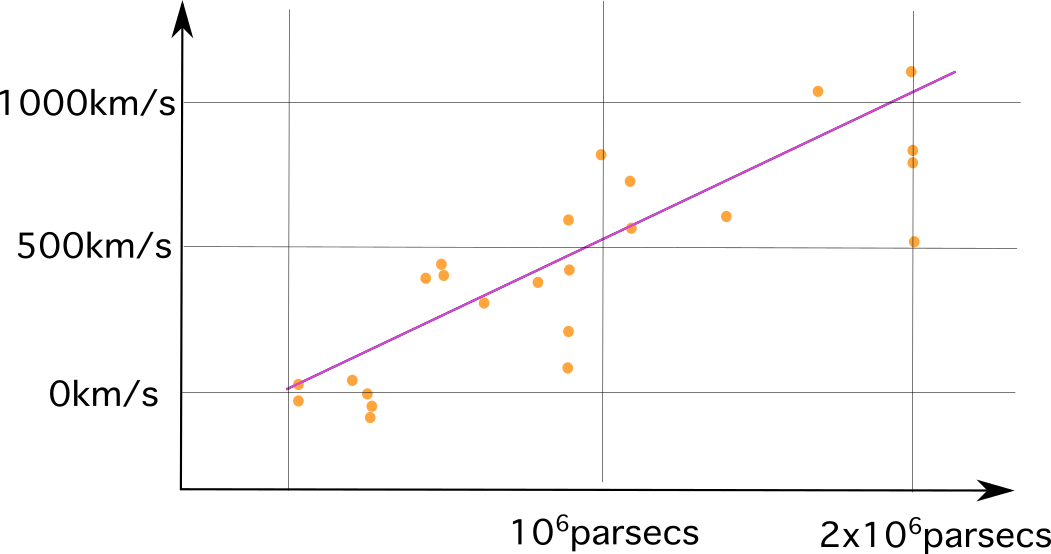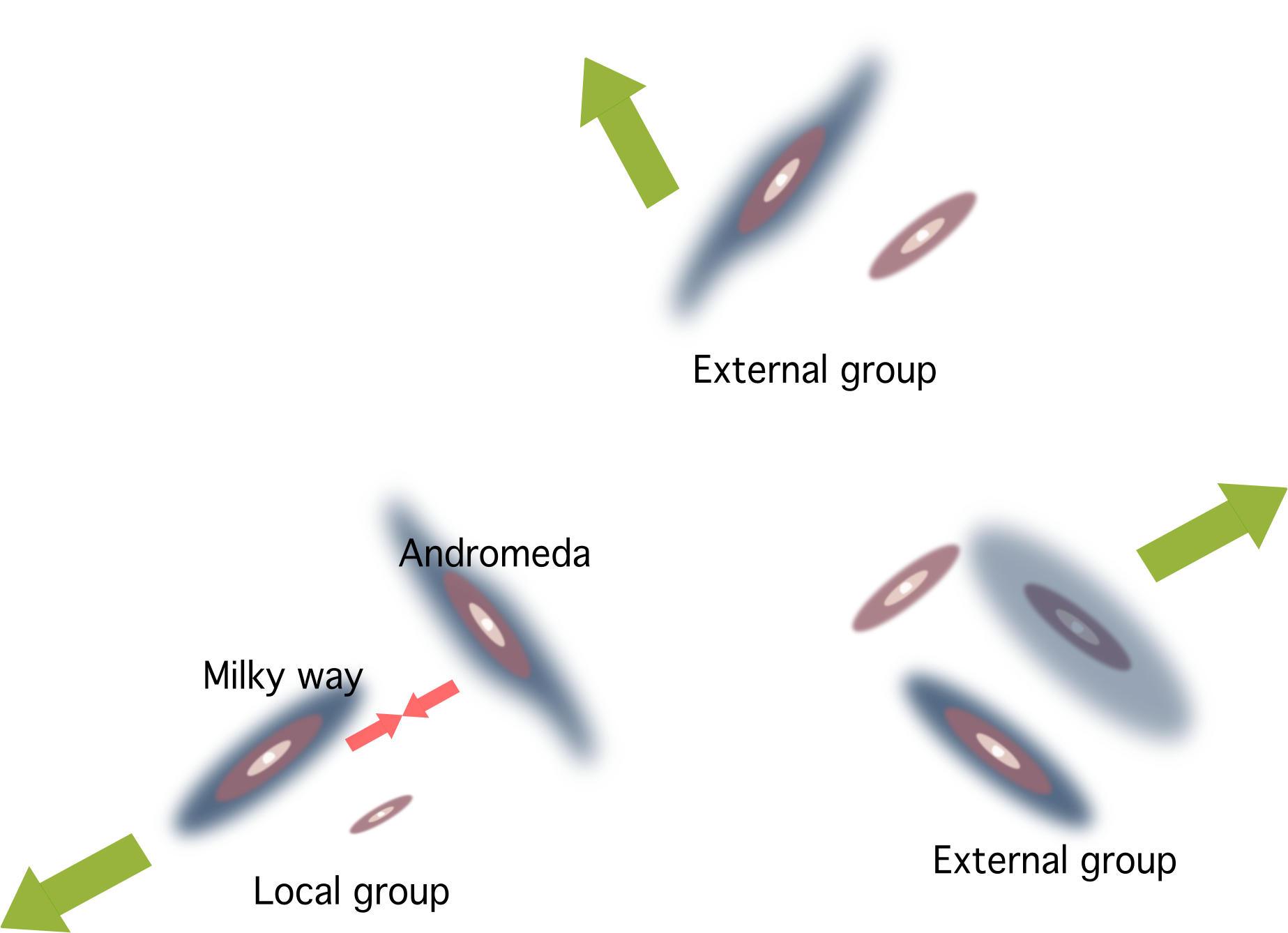Edwin Hubble made significant contributions to science. He observed a change in the light frequency of galaxies and provided critical evidence on the recessional velocity of galaxies. This observation led to the formation of Hubble’s law, which we look at in detail in this explanation.
The velocity of recession or recessional velocity is the velocity at which objects move away from an observer due to the expansion of the universe.
Hubble’s law explained
Edwin Hubble studied objects known as nebulae, and his doctoral studies focused on the observations of nebulae with a spiral shape. At the time, there were two theories on what spiral nebulae were:
- Spiral nebulae were either part of the Milky Way or nebulae outside the galactic plane.
- Spiral nebulae were galaxies far away from our own.
After observing the light emitted by the spiral nebulae, Hubble started noticing a pattern: the further away the nebulae were from Earth, the more the light shifted (Doppler shift) to the red part of the spectrum. By measuring the redshift of 20 spiral nebulae, Hubble concluded that galaxies are moving away from us at velocities that are proportional to their distance. This means that the further away a galaxy is from Earth, the faster it is moving away from us. In other words, the velocity of a galaxy increases the further away it is from Earth. This is known as Hubble’s law.
Hubble’s law is the observation that galaxies are moving away from us with a velocity that is proportional to their distance from us. In other words, further galaxies recede quicker than closer galaxies.
To understand Hubble’s law, we need to understand the Doppler effect. In the Doppler effect, a wave emitter moves with a certain velocity, and an observer receives this wave (in this case, light).
If the object moves closer to the observer, the light emitted is blueshifted, which indicates a decrease in the light’s wavelength. If the object moves further away from the observer, the light emitted is redshifted, which indicates an increase in the light’s wavelength.
According to the measurements, the accepted value of Hubble’s constant is 73.8km/s/Mpc (kilometres per second per megaparsec). This velocity might seem high to us, but it is not even 0.1% of the speed of light.
The increase of this velocity with distance and time predicts that galaxies might disappear from our range of vision at some point.
- You can check out our explanation on the Doppler Effect for more information and calculations.
- Also, don’t get confused between Hubble’s constant and how fast galaxies travel. Galaxies move at velocities according to how far away they are.
Hubble’s law graph
To find the relationship between the velocity of recession and the distance, Hubble analysed more than 20 galaxies. In his analysis, he plotted their distance from the Earth in parsecs against their velocity. You can see the results of this plot below:

An approximate recreation of Hubble’s law graph with data from Hubble calculations. Each dot represents an individual galaxy.
From this, Hubble concluded that an increasing linear relationship exists between the distance and the velocity.
A parsec (pc) is a length unit used to measure more considerable distances outside the Solar System (extrasolar distances). A parsec equals the distance covered by light in space during 3.26 years. Using this definition, Sirius, which is the brightest star in the Northern Hemisphere, is 2.64 parsecs away from Earth.
Hubble’s law equation
The linear relationship obtained by Hubble can be summarised with this simple equation:
\[v = H_0 \cdot D\]
Here, v is the recessional velocity in km/s, H0 is the slope of the line (also known as Hubble’s constant), and D is the distance from the galaxy to Earth measured in Mpc.
If you're interested, you should head on over to NASA's Hubble site to read up on how astronomers are able to measure accurately the universe’s expansion rate (including the use of a basic tool of geometry known as parallax).
Hubble’s law equation examples
Using the equation above, we can obtain the velocity of galaxies moving further away.
Calculate the velocity of the NGC 55 galaxy if it is at a distance of two megaparsecs from Earth.
First, we need to calculate the distance, and to do this, we must convert from parsecs to kilometres. We know a parsec is a distance covered by light in 3.26 light years. If the distance covered by light in a vacuum in one second is 300,000,000m, then we must multiply the distance by the number of seconds in one year, which is 31,556,926 seconds, and multiply this by 3.26.
\[\text{Distance covered by light in a year} = 31,556,926 \cdot (3 \cdot 10^8) = 9.4671 \cdot 10^{15}m\]
\[\text{Parsec distance} = 3.086 \cdot 10^{16}m\]
The NGC 55 galaxy is at two megaparsecs, so we now need to multiply the parsec distance per the parsec to NGC 55.
\[\text{NGC} \space 55 \text{(distance)} = 2 \cdot 10^6 \cdot (3.086 \cdot 10^{16}) = 6.17 \cdot 10^{22} m\]
Now, we can substitute this information into Hubble’s law equation and obtain the galaxy’s velocity. However, we must first convert the Hubble constant to metres per second per meter.
\[H_0=\frac{73.8 \cdot 10^3}{3.086 \cdot 10^{16}} = 2.39 \cdot 10^{-12} 1/s\]
And now we use Hubble’s law equation:
\[v = 1.476 \cdot 10^{11} m/s\]
Hubble’s law: redshifted and blueshifted galaxies
Hubble made two critical observations: he discovered that galaxies are moving further away from our own and observed that the further away the galaxies are, the more they accelerate.
Almost all galaxies present a redshift in the visible light, but there are some that don’t. These galaxies present a blueshift instead, which is the result of gravitational forces.
Blueshift is the decrease in the emitted wavelength as the emitter (the object producing the electromagnetic waves) moves closer to the observer.
Andromeda is one of these galaxies that has a blueshift. The blueshift of Andromeda is a product of the gravitational attraction between our galaxy (the Milky Way) and Andromeda, and it has been predicted that both will collide after some millions of years.

Andromeda and the Milky Way have a blueshift because the dominant
force between them is gravity (red arrows). Galaxies outside our group are not bound by gravity, so they follow the universal expansion (in green).
Did you know? Because Hubble’s law helps us to calculate (approximately) how much time has passed since galaxies started moving, researchers are able to gather information about the early stages of the universe and understand the Big Bang theory better.
Universe expansion
Hubble’s discovery of galaxies moving further away from our local group of galaxies laid the groundwork for other theories on the accelerating expansion of the universe. Later evidence came from measuring the redshift of stellar objects known as supernovae. Theories predict that the rate of expansion of the universe will increase as time advances.
A type 1a supernova is an explosion resulting from the interaction of two stars (better known as a binary system). In these binary systems, a white dwarf star and another star orbit closely. The white dwarf star absorbs some of the gas of its companion, and when it reaches a fixed mass, it explodes.
Because the mass at which this explosion happens is fixed, the luminosity is similar every time it happens. A near-constant luminosity can provide a constant flux of radiation (light), and researchers can use this to measure the distance of the star system. Observations of these binary systems were the ones that offered clues about the expansion of the universe (type 1a supernovae were travelling further away with time).
Hubble’s Law - Key takeaways
- Edwin Hubble observed a change in the light frequency of galaxies and provided critical evidence on the recessional velocity. This observation led to the formation of Hubble’s law,
- Hubble’s law is the observation that galaxies are moving away from us with a velocity that is proportional to their distance from us. In other words, further galaxies recede quicker than closer galaxies.
- Hubble concluded that an increasing linear relationship exists between the distance and the velocity.
- Almost all galaxies present a redshift in the visible light, but there are some that present a blueshift instead, which is the result of gravitational forces.
- The idea of an expanding universe was later corroborated by the study of type 1a supernovae in other galaxies.









